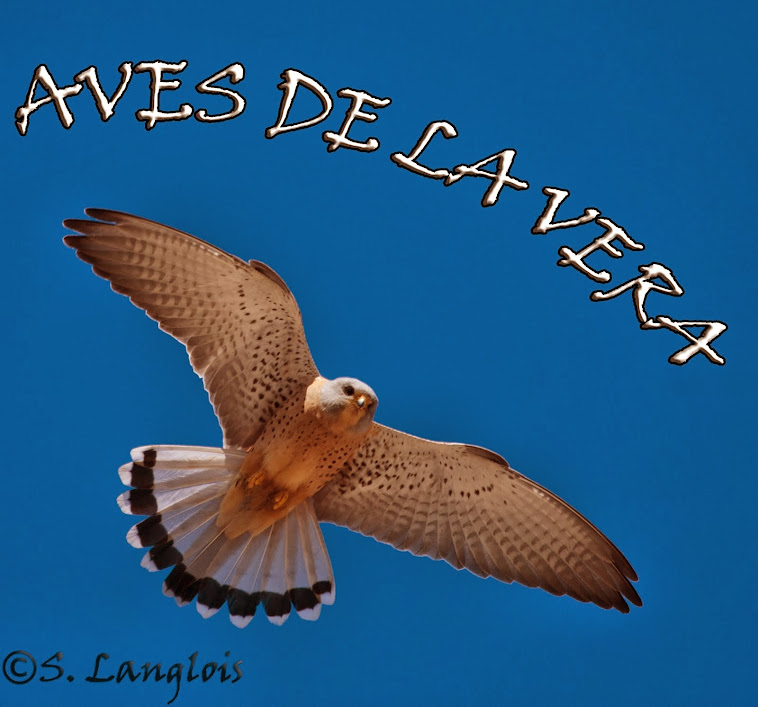La familia Hirundinidae es una de las más familiares en España por sus vuelos tan acrobáticos y llamativos y sus costumbres de vivir y criar tan cerca al hombre. Este año la Sociedad Española de Ornitología ha elegido la Golondrina Común como ave del año. Nos parece muy acertada la elección porque, además de bella, es un ave que se trata muy mal aquí en la Vera, tirando los nidos a veces con huevos y pollos dentro. En los últimos años la población de esta ave tan típica de los pueblos españoles ha caído en 30%. Sigue siendo común, pero ¿por cuánto tiempo más?
La mañana de 30 marzo la lámina de agua del embalse de Rosarito parecía hervir con la cantidad de “hirundínidos” que pululaban por la superficie cazando insectos. De vez en cuando se posan en árboles o, más a menudo, un posadero hecho por el hombre como cables o alambres. En las dos fotos a continuación vemos 4 de las 5 especies (falta avión roquero) que crían habitualmente en España.
En la primera vemos una docena de golondrinas en la fila de arriba con un avión zapador destacando a la derecha. En la fila de bajo vemos la otra golondrina de España, con la nuca dorada, la Golondrina Dáurica.
En la próxima vemos otra fila de golondrinas pero esta vez la octava por la izquierda es un avión común.
Esta misma mañana hemos visto otros pájaros a los que les gusta descansar en los alambres, como esta pareja de tarabilla común, la hembra:
. . . y el más apuesto macho:
En la siguiente foto la hembra hace gala de su capacidad de agitar todo su cuerpo, para arreglarse las plumas, manteniendo completamente quieta y rígida la cabeza para no perder ojo a su entorno:
Un hermoso jilguero también hizo acto de presencia:
Y por último las cigüeñas (otra especie de pájaro bellísimo que está sufriendo lo suyo últimamente con nidos tirados y antipatía general hacia ellos) nos brindaban sus estampas de siempre, tanto volando a ras de agua:
. . . como pastando al lado del ganado . . .
Así que esperamos que las campañas como las de SEO logren que estas bellezas y más sigan embelleciendo nuestra campiña muchísimos años más.
English translation of the text
LIKE A BIRD ON THE WIRE
The hirundine family is one of the best known in Spain due
to its aerobatic flight displays and welcome (to some) custom of living and
nesting so close to human beings. This year the Spanish Birdwatching Society (Sociedad Española de Ornitología: SEO)
has chosen the Swallow as its Bird of the Year. This strikes us as a very good
choice; these lovely birds are unfortunately often the victim of mindless
vandalism in La Vera, their nests being knocked down even with eggs or chicks
inside. IN recent years the population of this bird, such a typical sight in
Spain’s towns and villages, has shrunk by 30%. They’re still common, but for
how much longer?
On the morning of 30 March Rosarito Reservoir was absolutely
buzzing with insect-hawking hirundines. Every now and then they take a time-out,
perching in trees or, more often, on man-made structures like wires or cables. The
first two photos show 4 of the 5 species (the Crag Martin is missing) that
breed in La Vera. In the first we see a dozen or so Swallows with a Sand Martin
standing out on the right. On the lower line is perched Spain’s other swallow,
the Red-Rumped Swallow, showing off its golden nape. The second photo shows
another row of swallows but this time the eighth from the left is a House
Martin.
On this same morning, we also saw other passerines that like
to perch on wires, like this pair of male and female stonechats. In the last
photo the female is showing off its ability to shake its whole body to arrange
its feathers while keeping its head stock still. A beautiful Goldfinch also
came down to perch near us on a fence. Lastly, the White Storks (another
species suffering badly from knocked down nests and general aversion towards them)
gave us some of the usual lovely images, whether skimming over the water or
grazing alongside the cattle.
So let’s just hope that campaign like SEO’s manage to ensure
the presence of these everyday jewels in our countryside for some time to come.


















































